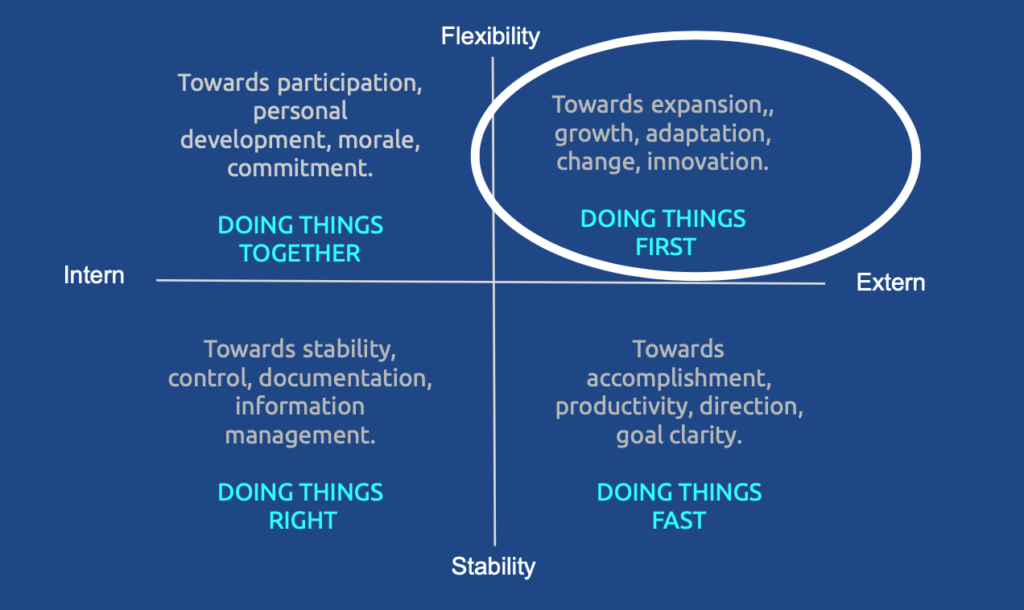
The change mindset
You need to do new things. Do things first. Having the right mindset for getting change done is a major step forward. In this post, Norbert Huijzer discusses the change mindset.

A mindset is a belief that orients the way we handle situations. It is the way we sort out what is going on and what we should do. So a change mindset is the mindset that guides us in changing someone or something. There is not one mindset. There may in fact be an infinite number of mindsets for any occasion.
Our mindsets help us spot opportunities, but they can also trap us in self-defeating cycles. If for example you are convinced doing things together (think: better teamwork and cooperation) are foundational to you or your organisation for more effective performing, chances are you might miss things like doing things right. Or you might even get stuck in an overkill of commitment, human development and communication.
At Kanso, we believe change always starts with a change mindset. It has proven effective to put your mind to the goals of change when building your business or organisation forward. A change mindset means you are inclined to believe that expansion, growth, adaptation, change, innovation and so on are the things you or your organisation needs the most to become someone or something different.
At Kanso, we like to organize our thinking about mindset along the lines of Quinn’s competing values.
Quinn created a framework that combines two dimensions of how people consider what is effective. The first value dimension is related to organizational focus, from an internal, micro emphasis on the well-being and development of people in the organization to an external, macro emphasis on the well-being and development of the organization itself. The second value dimension is related to organizational structure, from an emphasis on stability to an emphasis on flexibility
Combing those two, we see four quadrants. The upper left emphasises doing things together in the human relations tradition, whereas the lower left stresses the relevance of doing things right from an internal process perspective. In the lower right quadrant we find the rational goals of doing things fast and goal driven. In the left upper quadrant, we find the change orient open system models where doing things first are highlighted.

At Kanso we believe that complex or wicked stuff like mindsets is best expressed and shared as stories. Stories have purpose, humor and they tend to stick. So here are the seven stories we tell when it comes to getting change done.
Reach for the stars is our story about ambition. It is fuelled by our observation that change ever so often seems a matter of doing what has been done before. We think for successful change one should go for the highest attainable. Do not satisfice with what is readily and easily available.
You will see and hear us talking about chart the waters a lot. It stems from our observation that a lot of change simply lacks proper preparation. In our view you cannot stress enough the relevance of visualising your way ahead. You can’t foresee eevrything, but you can oversee what is to be expected as a lot of information is publicly available with little effort. Ignoring what is foreseeable is at least reprehensible and irresponsible.
Keep the fire burning is our adagium for making change happen. Frequently, we see change taking off high spirited, full of good intentions and energetic. After a while, everything seems to slow down, disappear in the background and things stay as they were. You should pay attention what is needed to be safe and sure, and get change done. You simply cannot dodge and trust that change will save itself.
No one will gladly admit to not keeping an open mind. Yet, sometimes our biases seem to take over. And then we stick to what we feel comfortable with, with what we know and have learned to appreciate. A change mindset means one can learn anything valuable from anybody, even (or often especially) from outside your organisation or area of expertise. Don’t see, trust and value only what you know and can do yourself.
Do accept that you need to make fixes work. Like legendary Dutch soccer player Johan Cruijff said, ‘a bag of money has never scored a goal’. Don’t rely on solutions to speak for themselves. There is no silver bullet or golden case that works every time for everybody. You have to understand what it is for people to make changes work.
Make all change personal. Meaning is always meaning to someone. People think, act, feel and so on in their own tempo, rhythm and manners. Don’t abstract or conceptualize. Your framework is an epistemic device, it is not what should happen in real life. Do embrace voluntary participation, as it is people who choose to make fixes work.
An last but not least, putting change first. Do focus on what you want to become. If you come out of rehab, there is a million things to do. Staying clean is the only thing your should focus on. So that is where your energy and resources are most valuable. Don’t think and act like everything is important at any time.
Here are a few rules of thumb we learned during our work in getting change done.
Be a tracker. Intentions are great. Measuring is better. There is such a thing as the mere-measure effect: By merely measuring your activity, you should see an improvement. Track your baseline and what you do. And learn to set realistic goals. You may assume everybody is committed and willing to spend time and effort towards your change. You may be wrong. Tracking identifies problems. But first and foremost, it is a great way of focussing attention and talk about what is going on with the team.
Be a storyteller. David Aaker said it spot on here: “People are not interested in your company, your brand, your product. They really aren’t, sad as that may be, and even if you get through with the message they’re skeptical. They question your motives. They sort of counter argue, all in the context of this media clutter we have. Along come stories. They’re more impactful than facts. They get attention. They get remembered. They change perceptions. They change attitudes. They precipitate behavior, and facts just don’t.”
Be a learner. Learn from the best. A lot has been written and thought out in the likes of systems thinking, design thinking and lean start ups. There are plenty of tips and tricks from critical thinking, creativity, storytelling. use these to your advantage.
Are you ready for a change mindset? Please do not hesitate to contact us.